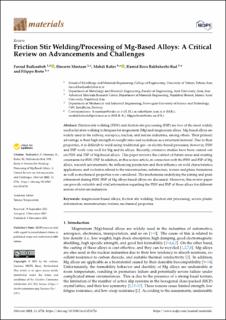| dc.description.abstract | Friction stir welding (FSW) and friction stir processing (FSP) are two of the most widely used solid-state welding techniques for magnesium (Mg) and magnesium alloys. Mg-based alloys are widely used in the railway, aerospace, nuclear, and marine industries, among others. Their primary advantage is their high strength-to-weight ratio and usefulness as a structural material. Due to their properties, it is difficult to weld using traditional gas- or electric-based processes; however, FSW and FSP work very well for Mg and its alloys. Recently, extensive studies have been carried out on FSW and FSP of Mg-based alloys. This paper reviews the context of future areas and existing constraints for FSW/FSP. In addition, in this review article, in connection with the FSW and FSP of Mg alloys, research advancement; the influencing parameters and their influence on weld characteristics; applications; and evolution related to the microstructure, substructure, texture and phase formations as well as mechanical properties were considered. The mechanisms underlying the joining and grain refinement during FSW/FSP of Mg alloys-based alloys are discussed. Moreover, this review paper can provide valuable and vital information regarding the FSW and FSP of these alloys for different sectors of relevant industries. | en_US |

